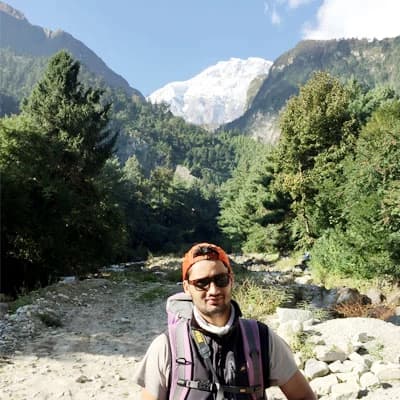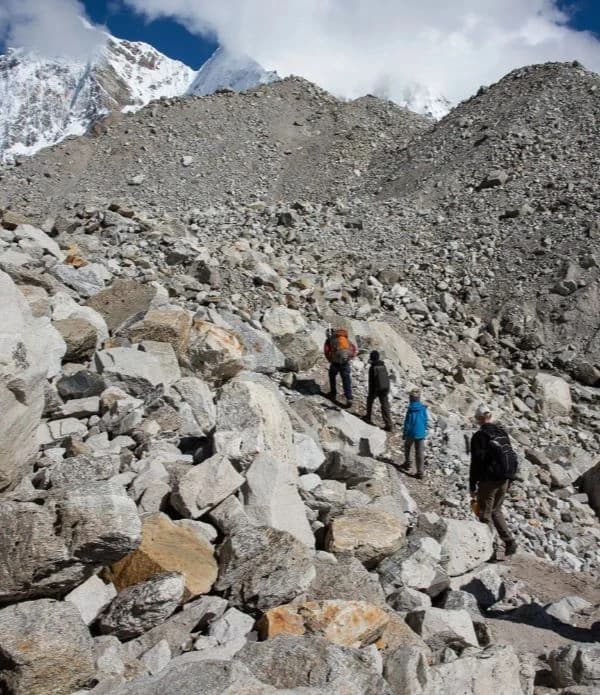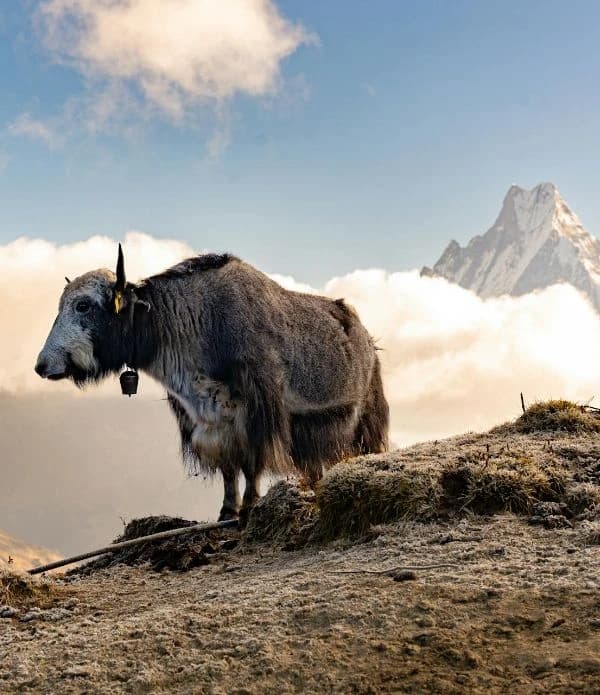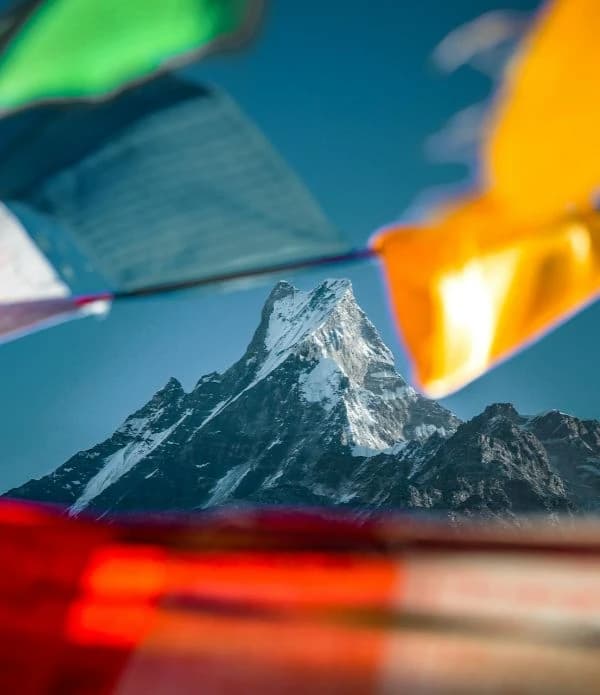If you are a seasoned trekker and looking to take your trekking experience to the next level, Nepal’s trekking peaks offer the perfect introduction to mountaineering.
Best Peak Climbing Trips in Nepal for Beginners
Combining the adventure of high-altitude trekking with the thrill of climbing, trekking peaks are ideal for beginners who want to experience the essence of Himalayan mountaineering without requiring advanced technical skills.
These introductory climbing peaks allow you to explore breathtaking landscapes, cross high mountain passes, and step onto glaciated summits, all while under the guidance of experienced climbing Sherpas.
All trekking peaks in our list are below 7000m and are ideal for those looking to step into the world of high-altitude climbs. Let’s take a closer look at why these trekking peaks stand out as the perfect entry point for beginners, each offering a unique experience that blends trekking with mountaineering in the Himalayas.
Mera Peak
For trekkers ready to take their first step into the world of mountaineering, Mera Peak offers the perfect challenge. Mera North, standing at 6,476 meters, is Nepal's highest trekking peak, but don't let its towering height fool you. Unlike other technical climbs, Mera offers a non-technical ascent, making it an ideal introduction for those seeking to elevate their trekking experience to new heights.
What makes Mera Peak unique is that it is not a single summit but a stunning massif with three separate peaks—Mera North (6,476m), Mera Central (6,461m), and Mera South (6,065m). The climb specifically targets Mera East Peak, offering an exhilarating yet accessible challenge, making it an ideal choice for beginners eager to experience the excitement of mountaineering.
Located in the stunning Everest region, the journey to Mera Peak combines the excitement of trekking through the iconic trails of the Khumbu region with the thrill of a summit push. The first few days follow the well-trodden Everest path, but soon, the trail branches off, taking you deep into the untouched beauty of the Hinku Valley. It’s here that you will begin to feel the adventure’s true essence—remote, serene, and far from the crowds.
While Mera Peak may be one of the highest trekking peaks in Nepal, the climb is surprisingly accessible for those with a good fitness level. With its gentle slopes and straightforward terrain, Mera introduces climbers to the basics of mountaineering without the fear of technical challenges. The brief section over Mera Glacier adds a touch of excitement, but the real reward is the stunning panoramic views of Everest, Lhotse, Cho Oyu, Makalu, and Kanchenjunga.
At Mera High Camp, the journey takes on a new level of adventure. As you camp beneath the towering peaks, you will experience the thrill of being amidst the towering peaks of the Himalayas. The day before the summit push, climbers undergo a training session, learning essential techniques for the final ascent, such as using ice axes and crampons, and understanding how to navigate the slopes safely.
This small yet crucial part of the experience boosts confidence and prepares trekkers for the challenges of peak climbing, setting the stage for their mountaineering ambitions.
|
Peak
|
Altitude
|
Route
|
Difficulty Level
|
|
Mera North
|
6,476 m
|
- Approach via Mera Glacier
- Steep slopes
- Ice climbing techniques required
|
Challenging: Technical skills required, with steep sections and exposure to ice and snow climbing.
|
|
Mera South
|
6,065 m
|
- Typically approached via Mera High Camp
- Steep and icy terrain
- Requires crevasse navigation
|
Moderate to Challenging: Demands some technical skills, including ice climbing and crevasse navigation.
|
|
Mera Central
|
6,461
|
- Approached via Mera Base Camp
- Easier than Mera North
- Non-technical climb with moderate snow and ice sections
|
Moderate: Non-technical climb, more accessible for beginners with basic trekking experience.
|
Island Peak Climbing (Imja Tse)
For trekkers eager to step into the world of mountaineering, Island Peak (Imja Tse) stands out for its thrilling ridge climb and technical glacier crossing. Standing at 6,189 meters, this popular trekking peak provides an exciting yet achievable ascent while also serving as a stepping stone for higher-altitude expeditions.
While Island Peak presents some technical sections, it is still well-suited for beginners with good fitness levels. The climb involves crossing a glacial field, ascending a steep headwall, and navigating fixed ropes before reaching the summit ridge. The real highlight is the breathtaking 360-degree panorama from the summit, offering spectacular views of Everest, Lhotse, Nuptse, Ama Dablam, and Makalu.
What makes Island Peak unique is its striking pyramid-shaped summit, rising sharply from the Imja Valley. The defining challenge of the climb is the steep 100m+ ice wall ascent, which demands endurance, precise footwork, and the use of fixed ropes. This final section is where climbers truly experience the essence of mountaineering, navigating a near-vertical slope before emerging onto the narrow summit ridge.
Like any other trekking peaks, climbers undergo essential training, learning to navigate fixed ropes, cross deep crevasses using ladders, and ascend the steep ice headwall that leads to the exposed summit ridge. Each step closer to the top demands focus and resilience as the thin air and challenging terrain push climbers to their limits.
The final ascent is a true test of determination, but the moment of triumph makes every effort worthwhile. Standing on the knife-edged summit, surrounded by an unbroken panorama of the world’s highest peaks, is an experience beyond words.
Lobuche East Peak Climbing
Lobuche East Peak, standing at 6,119 meters, is one of Nepal’s most sought-after trekking peaks, offering a thrilling yet achievable climb for beginners looking to step into the world of mountaineering. The peak is part of the Lobuche Massif, which consists of Lobuche East and Lobuche West.
The journey begins with familiar trekking paths, passing through the famous Sherpa villages of the Khumbu region, where the landscape gradually transforms as you ascend toward higher altitudes. The real mountaineering begins as you approach Lobuche East.
While the peak isn’t technically difficult, it does require the use of essential climbing tools like crampons, ice axes, and fixed ropes—skills that will be invaluable for future expeditions. The ascent requires careful footwork, but the non-technical nature of the climb makes it accessible to beginners. It’s an ideal introduction to navigating glacier-covered slopes, using fixed ropes, and learning proper technique for climbing steep sections safely.
Summiting Lobuche East is a true accomplishment, offering an unforgettable experience that bridges the gap between trekking and more advanced mountaineering. The climb prepares you for future expeditions by teaching foundational skills, while the panoramic views from the summit of Everest, Lhotse, and other surrounding peaks offer a reward that makes the entire journey worthwhile.
Pisang Peak
Pisang Peak, standing at 6,091 meters, is a striking trekking peak in the Annapurna region, offering climbers an exhilarating yet achievable introduction to mountaineering. Unlike other trekking peaks, Pisang Peak is uniquely positioned along the world-famous Annapurna Circuit, providing a rare combination of high-altitude climbing and one of Nepal’s most scenic trekking routes.
Unlike isolated trekking peaks, Pisang rises dramatically above the village of Pisang, with its sharp ridges and snowy slopes forming a stunning contrast against the dry landscapes of Manang. The ascent to the summit is not a straightforward trek that involves navigating steep scree slopes, glacier crossings, and a thrilling final snow ridge that adds a true sense of mountaineering adventure.
The real challenge of Pisang Peak begins after reaching the high camp, set at around 5,400 meters. From here, climbers face a steep ascent over loose moraine and icy slopes before stepping onto the final ridge—a narrow, knife-edged path with sharp drop-offs on either side. The climb includes mixed terrain with rocky trails, glaciated sections, and a sharp snow ridge, providing climbers with exposure to different mountaineering elements in a single expedition.
While some trekking peaks have long, sustained snow slopes, Pisang Peak requires a mix of skills: traversing scree-covered moraines, using ice axes and crampons for stability on icy patches, and managing fixed ropes on steeper inclines. This diversity makes it an ideal training ground for climbers aiming for more advanced expeditions.
Additionally, Pisang Peak is uniquely positioned along the Annapurna Circuit, offering an acclimatization advantage that many other trekking peaks lack. Unlike expeditions that involve rapid altitude gain, this climb allows trekkers to adjust gradually as they pass through vibrant Manangi villages and high-altitude settlements like Upper Pisang and Ngawal.
Yala Peak
Yala Peak is one of the most accessible trekking peaks in Nepal, making it an excellent choice for beginner climbers eager to enter the world of mountaineering. Located in the stunning Langtang region, this 5,732-meter peak offers an exciting yet achievable ascent, providing the perfect foundation for those looking to take on more technical challenges in the future.
The significance of Yala Peak is its strategic location near the Tibetan border, offering unparalleled views of towering Himalayan giants. From the summit, climbers are rewarded with a breathtaking panorama of Shishapangma, Langtang Lirung, Dorje Lakpa, and Ganchenpo. The sense of accomplishment upon reaching the top is unmatched, making the journey as fulfilling as the destination itself.
Yala Peak is an ideal training ground for novice climbers as it introduces essential mountaineering skills without excessive technical difficulty. The route involves glacier travel, walking on ice and snow with crampons, and using ropes for added security on certain sections. Unlike peaks that require steep ice or rock climbing, Yala Peak offers a relatively straightforward ascent, allowing climbers to focus on building endurance, acclimatization, and confidence at high altitudes.
While the climb does not demand advanced technical skills, it still requires physical fitness and mental resilience. The high-altitude conditions, cold temperatures, and long trekking days challenge climbers, preparing them for more demanding Himalayan expeditions. Every step toward the summit is an opportunity to strengthen mountaineering abilities and experience the thrill of high-altitude adventure in a safe and supportive environment.
For those seeking their first true Himalayan peak, Yala Peak offers the perfect blend of adventure, skill development, and breathtaking scenery. It serves as an essential stepping stone for future mountaineering aspirations, making it a must-do climb for trekkers eager to transition into alpine expeditions.
Summarized Comparison of Trekking Peaks in Nepal
If you're considering trekking a peak in Nepal, it's important to understand its unique characteristics.
Here’s a comparison of these three popular peaks to help you decide which suits your adventure goals.
|
Peak
|
Altitude
|
Region
|
Key Features
|
Experience Needed
|
|
Mera North
|
6,476 m
|
Khumbu/ Everest
|
- Non-technical, highest trekking peak.
- Long summit day.
- Panoramic view of 5x 8,000m peaks.
|
- No technical skills needed.
- Good fitness required.
- Basic use of crampons and ice axe helps.
|
|
Island Peak (Imja Tse)
|
6,189 m
|
Khumbu/ Everest
|
- Steep ice wall climb with fixed ropes.
- Glacier travel & crevasse crossings.
- Exposed summit ridge.
|
- Suitable for beginners.
- Prior trekking & altitude experience.
- Pre-climb training at base camp.
|
|
Lobuche East
|
6,119 m
|
Khumbu/ Everest
|
- Technical with rocky ridges & snow slopes.
- Mixed climbing.
- Exposed final push.
|
- Requires mountaineering skills (ropework, mixed terrain).
- Prior high-altitude trekking experience is helpful.
|
|
Pisang Peak
|
6,091 m
|
Annapurna Region
|
- Steep ascent with moraine & icy slopes.
- Narrow exposed ridge.
- Requires climbing skills.
|
- Requires mountaineering skills (ice axes, crampons, fixed ropes).
- Prior mountaineering experience is recommended.
|
|
Yala Peak
|
5,732 m
|
Langtang Region
|
- Non-technical, ideal for beginners.
- Panoramic Langtang Himal views.
|
- No technical skills needed.
- Good fitness & trekking experience recommended.
|

.webp&w=3840&q=75&dpl=dpl_5no2mbdoNHZofbQzNp4xwNy1a21g)



.webp&w=1200&q=75&dpl=dpl_5no2mbdoNHZofbQzNp4xwNy1a21g)



